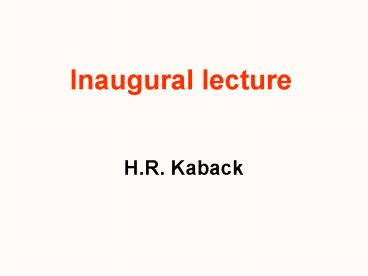Inaugural lecture H.R. Kaback - PowerPoint PPT Presentation
Title:
Inaugural lecture H.R. Kaback
Description:
While ATP is the currency of energy exchange in the cytosol, electrochemical ion ... from pre-synaptic cells and binds to the nicotinic acetylcholine receptor ... – PowerPoint PPT presentation
Number of Views:22
Avg rating:3.0/5.0
Title: Inaugural lecture H.R. Kaback
1
Inaugural lecture H.R. Kaback
2
Bioenergetics in energy-transducing membranes
represents the bridge between biochemistry and
physiology. While ATP is the currency of energy
exchange in the cytosol, electrochemical ion
gradients across energy-transducing membranes are
involved in a large number of seemingly unrelated
processes such as oxidative phosphorylation,
active transport of many different metabolites,
signal transduction, maintenance of internal pH,
intracellular organelle function, protein
secretion, bacterial motility, and other cellular
processes.
3
(No Transcript)
4
Epithelial transport.
Transport across the epithelium of the intestine
will be discussed briefly merely to demonstrate
the similarity of the basic principles. The
topic will be discussed in more detail by
Professor Wright. At the lumenal or brush-border
side of this polarized intestinal epithelial cell
(top), sodium and glucose are symported via a
sodium-coupled symport protein (SGLT1), leading
to accumulation of glucose against a large
concentration gradient in the cytosol. The
accumulated glucose is then allowed to flow down
its chemical gradient via a glucose uniporter
(a.k.a., facilitated diffusion carrier) on the
basolateral surface (bottom) into the serosal
fluid, and sodium is pumped out on the
basolateral surface by the Na/K-ATPase. The
tight junctions keep the membrane proteins on the
brush border from mixing with the proteins on the
basolateral membrane and vice versa.
5
Synaptic function in the CNS.
At neuromuscular junction,
acetylcholine is released from pre-synaptic cells
and binds to the nicotinic acetylcholine receptor
on the muscle cell membrane, thereby opening a
sodium channel which leads to depolarization of
the post-synaptic muscle cell. Subsequently, the
signal is terminated by acetylcholine esterase
which hydrolyzes the neurotransmitter, and in
addition, the acetylcholine receptor becomes
desensitized. In contrast, at synapses in the
CNS, the primary means of terminating the signal
is by re-uptake of neurotransmitters (e.g.,
dopamine, serotonin, glutamate, glycine) into the
pre-synaptic cell and subsequent repackaging into
synaptic vesicles.
6
(No Transcript)
7
The next three lectures will focus primarily
upon one aspect of bioenergetics, active
transport of metabolites in a specific
experimental model system, bacterial cytoplasmic
membrane vesicles, which revolutionized the field
by leading to the development of similar systems
from epithelia and the nervous system. The
intent is to use this highly defined system to
give you a feel for what an electrochemical ion
gradient is, how the components are measured in
microscopic systems that are not readily amenable
to electrophysiology and how one can demonstrate
convincingly that an electrochemical ion gradient
is the immediate driving force for the
accumulation of metabolites. The general
relevance of this relatively simple experimental
system to more complex systems that have direct
relevance to human physiology will be
illustrated.
8
ReadingLectures from Professors Bezanilla and
Wright contain related information that will help
you understand the concepts under
consideration.For those of you who would like
more in-depth reading, the following are
suggested
Kaback, H.R. 1971. Bacterial membranes.
Methods in Enzymology 22, 99-130 Nichols, D. G.
and Ferguson, S. 1992. Bioenergetics 2
(Academic Press, London).































